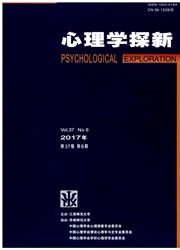

 中文摘要:
中文摘要:
在面孔识别研究领域中,大量研究探讨人类对这一类刺激的加工是否具有与其他刺激不同的认知神经机制,即面孔的加工具有领域特异性还是过程特异性?由于各类研究使用的方法各不相同,导致对这一问题的回答尚缺乏一致性。本研究假设,如果面孔刺激具有特异性,无论在何种任务被试采用何种加工方式下,人类面孔N170反应在统计值上均显著高于其他类别的N170反应;相反,面孔与其他刺激在N170上则没有统计上的差异。研究将人类面孔、动物面孔、水果/蔬菜、房屋4类刺激呈现在不同任务设置下,测量人类面孔在不同任务中与各类刺激间的早期反应差异。当前研究结果发现,人类面孔在不同任务中始终保持着比其他刺激更为显著的ERPs(Event-Related Potentials,ERPs)反应优势,表现在额中部的早期正成分VPP和右侧颞枕部负成分N170对人类面孔反应幅度显著高于其他三类刺激的。人类面孔与其他刺激的ERP间差异反应模式在不同任务下相对稳定,并末发现动物面孔有类似效应。研究结果支持人类面孔加工的领域特异性说法。
 英文摘要:
英文摘要:
Most studies on face recognition concern whether human face processing is domain- specific or process- specific. Due to inconsistent methodologies among these studies,the answer to the issue is poorly understood. The present study hypothesized that no matter what tasks and methods have been employed,the N170 for human faces would show significantly larger amplitude relative to that for the other categories if face processing was specific; by contrast,N170 for human faces had no statistically significant difference from other stimuli. Four categories of stimuli including human faces,animal faces,fruit /vegetables,and houses were presented under different experimental settings; the early brain response to these stimuli was measured and compared in different tasks,separately. The current study found that the brain response to human faces always keep its advantages over stimuli in different tasks,showing more significant central- VPP and right occipito- temporal N170 amplitude than the other stimuli. The response patterns for human faces were relatively stable under different tasks. But brain response to animal faces which is considered to share common with human face,didn't show much differences from other stimuli. The findings support the human face specificity account.
 同期刊论文项目
同期刊论文项目
 同项目期刊论文
同项目期刊论文
 Electrophysiological correlates of early processing of visual word recognition: N2 as an index of vi
Electrophysiological correlates of early processing of visual word recognition: N2 as an index of vi Different neural substrates underlying directed forgetting for negative and neutral images:An event-
Different neural substrates underlying directed forgetting for negative and neutral images:An event- Evaluation of the psychometric properties of the Chinese version of the Resilience Scale in Wenchuan
Evaluation of the psychometric properties of the Chinese version of the Resilience Scale in Wenchuan Different brain mechanisms between stereotype activation and application: Evidence from an ERP study
Different brain mechanisms between stereotype activation and application: Evidence from an ERP study Self-esteem modulates attentional responses to rejection: evidence from event-related Brain Potentia
Self-esteem modulates attentional responses to rejection: evidence from event-related Brain Potentia 期刊信息
期刊信息
